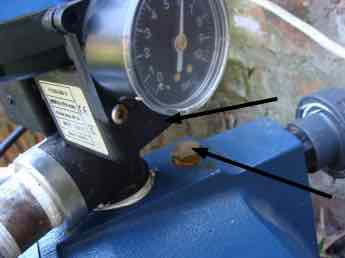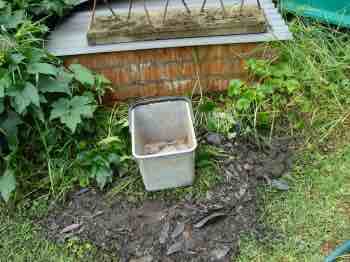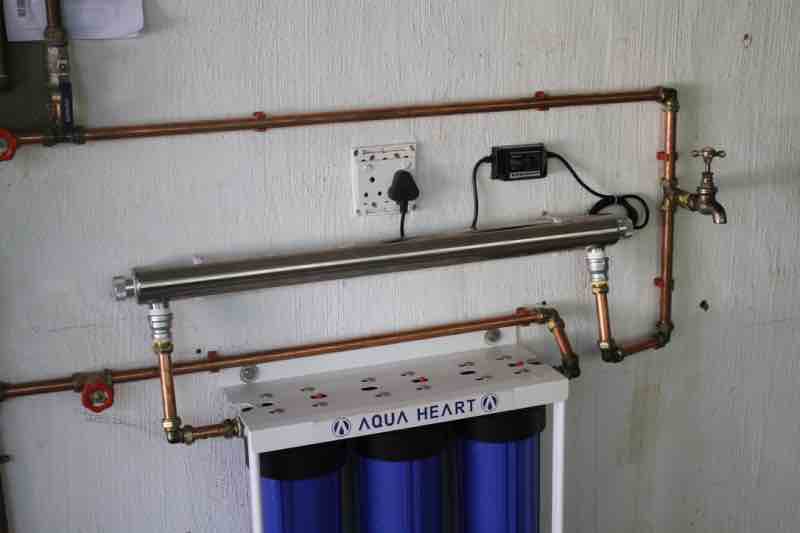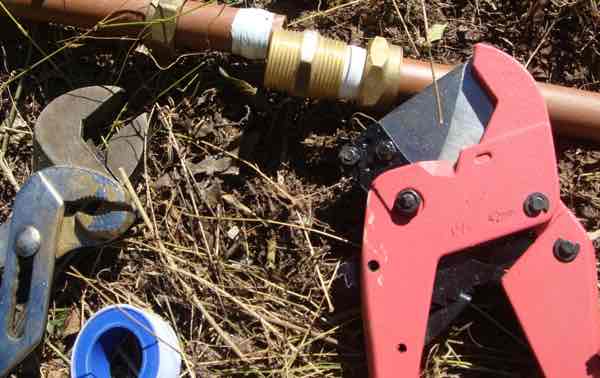- Bernard Preston homepage
- Harvesting Rainwater
- Self-priming Pumps
Self-priming pumps
Self priming pumps are the best for your rainwater-harvesting, particularly if your reservoir is underground; then they must be situated higher than the level of the liquid.
This page was last updated by Bernard Preston on 24th May, 2021.

Either you have to fill it regularly via that brass bolt that is arrowed above, or purchase one of the self-priming pumps.
With the older type, unless there is water pressure filling the little enclosed tank, it tends to run dry, even if you have a foot valve, and you have frequently to open the bolt arrowed, and top it up manually.
They do work, and I used one for six months, but was glad to change over to the more user friendly modern kind; it clears itself automatically of air.
- Bernard Preston homepage
- Harvesting Rainwater
- Self-priming Pumps
In fact, it now transpires that your self-priming pump isn't so modern; lower down on this page you can read about the inverter motor.
There are two situations you might consider. In both cases, the rainwater must be harvested for the reservoir that collects the runoff that gravitates from your roof; it will of necessity lie lower than your home.
In order to use the rainwater in your home, you'll have to use a pump, either way.
If you live on sloping ground, so that a fibreglass tank can be located above your home, then first prize is to pump the water from the reservoir to the container, which then gravity feeds to your house and garden. If you have a double story, then it will have to be higher still to give enough pressure; unsightly and expensive to erect and difficult to work on.
Or you can use a second pump; this is probably the
best situation because most homes will have small leaks somewhere; also
the pressure valve to your geyser produces a steady drip during the day.
On level, or gently sloping ground, as we have, you must either put in a very high stand for your tank, or accept that every time you switch on a tap, the pump comes on. It is less desirable, but it works. That's the situation we have.
Self-priming pumps
Self-priming pumps are a lot more user friendly and not much more expensive.
Note the brass bolt arrowed above. There is a temptation not to tighten them, so this definitely must have plumber's tape. Just above the head is the electronic brains of the machine, also highlighted. If water squirts up into the mechanism, it will short circuit your self-priming pump.
In short, make sure you use plumber's tape, when you fill the pump for the first time. Thereafter, mostly, it will prime itself.
This is no joke; it happened to me. A rather expensive and irritating learning curve unless you are a plumber, builder and electrician, all in one.
On the right you can see the incoming pipe from the reservoir. The pump is marginally above the water when the tank is full, and up to two metres above the level when there's been no rain for some months.
The pump handles this with ease.
Obviously it is vital that there are no leaks in the system, or the pump will be cycling every few minutes. For this reason, I use a shut off tap for water to the garden. Somewhere underground there are small losses which I cannot locate, but enough to irritate. It is not that big a deal to switch it on when you want to irrigate the vegetables.
Rainwater harvesting model
A rainwater harvesting model should be consider before plunging into a new venture, requiring moderately expensive items like self-priming pumps; about 300 dollars.
- How is the rainwater going to be collected from the downpipes from the gutters?
- Is the rainwater going to be collected in tanks or a reservoir. Can it be put underground where the water is much colder and safer? Which is cheaper for the amount of water you need?
- If the pump is higher than the water, a self priming pump is a must.
- Are you going to use a filter and perhaps an ozone sterilising device?
- Will the pump have a pressure bladder?
- Should the reservoir be fibreglassed?
- Who is going to take the responsibility for cleaning the gunge that makes its way into the reservoir?
These are all questions that Bernard Preston found important to consider before making a start. So, what's your water innovation?
Your own water supply without chlorine is one of the secrets of starting urban agriculture in your own garden.
Gunge

Rainwater harvests a lot of gunge too. In order to keep your self-priming pumps free from particulate matter the trap needs to be cleaned regularly. It only takes about ten minutes, plus the time to syphon out the water; do it about once a month, or your water will start to smell.
Getting siphon started on sump is really simple; but it does take a little understanding of the physics involved; about grade 7 science!
Those rainwater harvests are par for the course. Leaves collect in the gutters and dust falls on the roof; it cannot be avoided. Otherwise you must use a filter to remove the particulate matter.

After much debate we finally did away with the filter, and have no problems.
The filter needs to be replaced every few weeks and significantly drops the pressure; it wouldn't remove any bacteria that may concern you. I did worry us initially, but we found that because the underground water is cold that's it's entirely potable.
I considered putting in an ultraviolet steriliser, but it proved unnecessary; you may want to consider it.

If you are going to do some home-based plumbing, do yourself a favour and purchase one of these polycop pipe cutters. I wish I'd done so years ago; they cut the pipe accurately and very simply and cleanly; it is easy.
With a hacksaw you get a burred edge. It's difficult to slip the compression ring olive on and they are more likely to leak. You really need to tighten them properly; don't be afraid that you will strip the brass; a bit of putty may be necessary.
No more leaks!
Incidentally, should your reservoir run dry, make sure you turn over the pump at least once a week for a few seconds. Mine just seized after a six week stoppage; luckily it was not difficult to open and free up; there was no damage done, but it was an unnecessary chore.
Digital inverter motor
If I was purchasing a new water pump today, I would go to digital inverter motor technology[1].
When browsing use right click and Open Link in New Tab, or you may get a bad gateway signal.
Newsletter
Our newsletter is entitled "create a cyan zone" at your home, preserving both yourself and Mother Earth for future generations; and the family too, of course. We promise not to spam you with daily emails promoting various products. You may get an occasional nudge to buy one of my books.
Here are the back issues.
- Lifestyle and ideal body weight
- What are ultra-processed foods?
- Investing in long-term health
- Diseases from plastic exposure
- Intensive lifestyle management for obesity has limited value
- A world largely devoid of Parkinson's Disease
- The impact of friendly bacteria in the tum on the prevention of cancer
- There's a hole in the bucket
- Everyone is talking about weight loss drugs
- Pull the sweet tooth
- If you suffer from heartburn plant a susu
- Refined maize meal and stunting
- Should agriculture and industry get priority for water and electricity?
- Nature is calling
- Mill your own flour
- Bake your own sourdough bread
- Microplastics from our water
- Alternative types of water storage
- Wear your clothes out
- Comfort foods
- Create a bee-friendly environment
- Go to bed slightly hungry
- Keep bees
- Blue zone folk are religious
- Reduce plastic waste
- Family is important
- What can go in compost?
- Grow broad beans for longevity
- Harvest and store sunshine
- Blue zone exercise
- Harvest and store your rainwater
- Create a cyan zone at your home
With the old single speed motor when the pressure in the reticulation drops below a certain level, the pump suddenly switches on, giving a familiar noise, and it operates at full power until it rises sufficiently and then abruptly turns off.
Unlike the old pumps, these new inverter motors are almost always on, but operate at different speeds. This is far more efficient with significant savings in electricity, less noise and stress on the pump; they should last longer.
They use up to 50 percent less electricity apparently and small leaks in the reticulation are not a problem. It would obviate having to put in an elevated storage tank, and second motor in many situations.
Read more at what is an inverter?
Bernard Preston
Bernard Preston is a semi-retired DC who still loves to use his hands. Fiddling with things like self priming pumps is one of those gadgets that has fascinated him.
Having plenty of clean water for the home and garden is vital for those on the green journey.
Useful links
Did you find this page interesting? How about forwarding it to a friendly book or food junkie? Better still, a social media tick would help.
- Bernard Preston homepage
- Harvesting Rainwater
- Self-priming Pumps
Address:
56 Groenekloof Rd,
Hilton, KZN
South Africa
Website:
https://www.bernard-preston.com